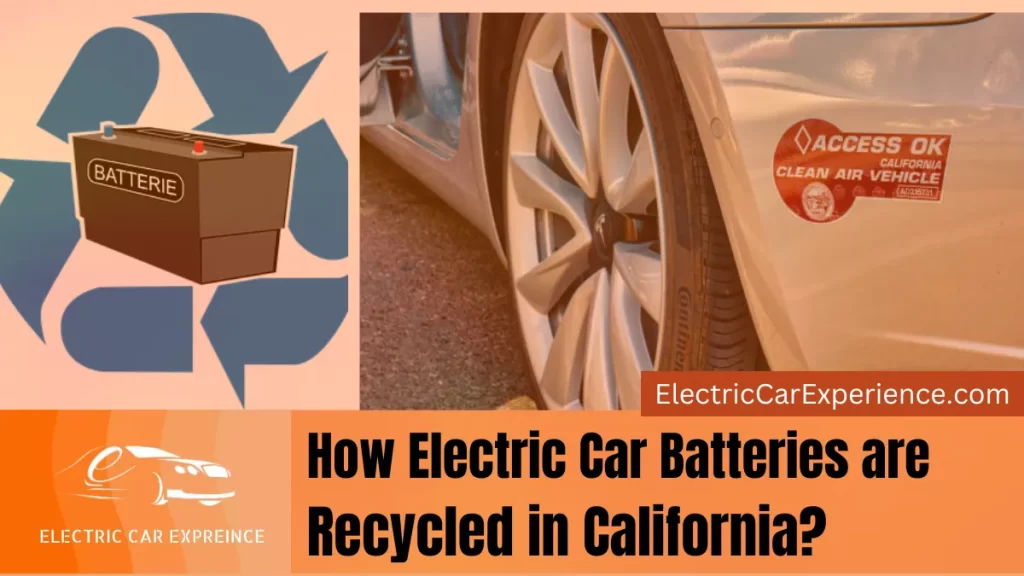
California has a number of regulations in place to encourage the recycling of electric car batteries. The state recognizes that these batteries contain valuable metals and materials that can be reused, and that recycling them can help reduce waste and conserve resources. How Electric Car Batteries are Recycled in California?
Recycling electric car batteries involve “crushing and grinding.” The batteries are first broken up into tiny pieces, and the pieces are then powdered. To manufacture fresh, recycled electric car batteries, this powder is next combined with water and other chemicals. The water aids in the powder’s dissolution as the chemicals break down the battery’s plastic and metal components. It’s possible that electric car battery recycling will advance in the future, allowing for more battery utilization.
Top 5 Ways of Recycling Electric Car Batteries in California are:
- Recycling of electric car batteries has begun in California.
- Depending on the type of battery, the process for recycling electric car batteries varies.
- Importance of Battery Recycling for Electric Vehicles.
- Life of Electric Cars’ Batteries.
- Polluting Electric Car Battery Disposal.
We need to see this topic in detail.
Recycling of electric car batteries has begun in California.
Recycling scheme in California.
Ex-Tesla CTO J.B. Straubel launched Redwood Materials Inc., which is introducing an electric vehicle battery recycling scheme in California. Ford and Volvo are the first automakers to collaborate with the Carson City, Nevada-based business.

Redwood materials.
In a news statement this week, Redwood Materials stated that it will collect and recycle hybrid and electric vehicle (EV) battery packs to create new battery materials once they have reached the end of their useful lives. In the state of California, it declares that it will accept all lithium-ion and nickel-metal hydride batteries.
“We must create a closed-loop supply chain that efficiently recycles used batteries and remanufactures them into new ones. This is essential to achieving the electrification goals of both California and the United States as a whole “In a video posted to the business’s YouTube channel, Straubel added.
Although hybrids have been available for a while, the first significant wave of EVs that will be phased off the road won’t happen for a few more years. Redwood Materials is not the only company creating recycling infrastructure and technologies in front of the anticipated influx of tapped-out batteries, though.
Ascend Elements, a Massachusetts-based firm with aims to establish the largest battery recycling facility in North America, struck a deal with Honda last year to supply the automaker with new cathodes built from recycled lithium-ion batteries.
According to the business, Redwood Materials already recycles enough batteries annually for 60,000 EVs or more than 6 gigawatt hours.
Volvo Accomplish.
Battery recycling will help Volvo accomplish its goals of becoming a circular corporation by 2040 and having a fully electric vehicle range by 2030. Ford has set a goal of becoming carbon-neutral by 2050 and has previously invested $50 million in Redwood Materials.
Gov. Gavin Newsom was quoted in the company’s promotional video as saying, “It goes without saying that California is on the front lines of climate change. “With wildfires blazing and droughts setting records, we know there is no time to spend,”
Biden’s administration wants Ev sales.
By 2035, California intends to ban the sale of new gas and diesel vehicles. According to Bloomberg, the state’s environmental agency is collaborating with Redwood Materials to help organize recycling activities. By 2030, the Biden administration wants EV sales to account for 50% of all vehicle sales.
The administration recently pledged $5 billion in assistance for states to develop charging infrastructure to help them achieve that objective. The future of EVs will be shaped equally by battery recycling, which will reduce e-waste and the need for hazardous mining techniques to obtain minerals like lithium.
Depending on the type of battery, the process for recycling electric car batteries varies.
The first step in recycling an electric vehicle battery is chemistry classification. Batteries made of lead-acid, nickel-cadmium, and lithium-ion are recycled using various techniques.

Recycling for Lead-acid battery.
Crushing lead-acid batteries and extracting the lead and other metals from the battery allows for their recycling. After being cleaned, the lead is either sold to businesses that produce paint, pipes, and other goods, or it is used in fresh lead-acid batteries.
Recycling for Nickel-Cadmium battery.
Batteries made of nickel-cadmium are recycled by being crushed and having the nickel and cadmium removed by smelting. After being refined, the nickel is either used in new nickel-cadmium batteries or sold to businesses that produce solar panels, automobiles, jewelry, and other goods.
Recycling for Lithium-ion Battery.
Crushing lithium-ion batteries and extracting the lithium from them allows for their recycling. Following purification, the lithium is either used in fresh lithium-ion batteries or sold to businesses that produce laptops, phones, drones, and other goods.
Electric vehicle battery recycling is crucial since it lowers the number of electric vehicles disposed of in landfills. Additionally, it promotes job growth in the recycling sector.
Importance of Battery Recycling for Electric Vehicles.
Because they contain valuable elements that can be used to make new batteries, electric car batteries must be recycled. We can maintain our environment clean and lessen our reliance on fossil fuels by recycling these batteries. Additionally, recycling electric car batteries promotes job growth in the battery production sector.
Recycling electric car batteries are essential for the environment since it lowers the quantity of waste produced. We can lessen the production of plastic by recycling the batteries from electric vehicles. In addition, we can lessen the number of metals released into the environment by recycling the batteries from electric vehicles.
Life of Electric Cars’ Batteries.
Although the popularity of electric vehicles is growing, the longevity of their batteries is constrained. Batteries for electric vehicles typically have a lifespan of 10 to 20 years, although they will eventually start to deteriorate and need to be replaced. We must stress that degradation does not equate to death.
It indicates that the battery won’t maintain a charge as well as it formerly did. Imagine the battery life and storage capacity of your previous mobile phone decreasing day by day.
Polluting Electric Car Battery Disposal.
Chemical Recycling.

Batteries for electric vehicles are typically recycled using a method known as “chemical recycling.” The battery is disassembled into its constituent pieces during this operation. Each component of the battery has a particular role since different types of batteries are produced from various materials. For instance, the plastic and metal pieces are utilized to produce new plastic and metal things, but the lead and acid battery elements are used to create new lead and acid batteries.
Mechanical Recycling.
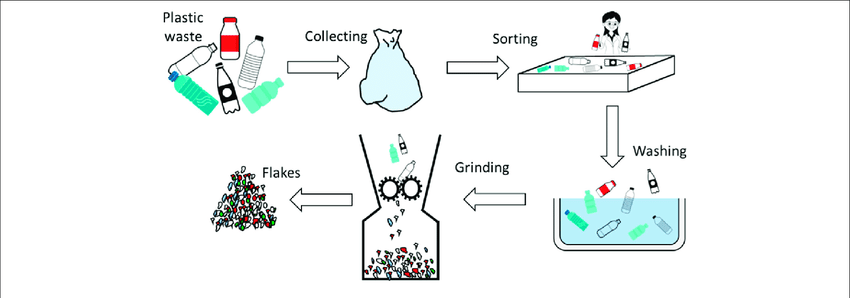
On the other hand, “mechanical recycling” is typically used to recycle lithium-ion batteries. The battery is disassembled into its constituent pieces during this operation.
In contrast to the plastic and metal components, which are used to make new plastic and metal products, lead and acid battery parts are utilized to make new lead and acid batteries.
Batteries for electric vehicles are not entirely pollution-free when it comes to disposal. Some of the hazardous components that were in the electric car battery will be discharged into the atmosphere when it is recycled. Acid, lead, and mercury are just a few examples of these materials.
Even some components thought to be safe when they are in the battery can be dangerous when they are released into the atmosphere. Researchers are trying to figure out a technique to recycle electric car batteries without dispersing these dangerous substances in the air.
How Are Batteries for Electric Vehicles Recycled?
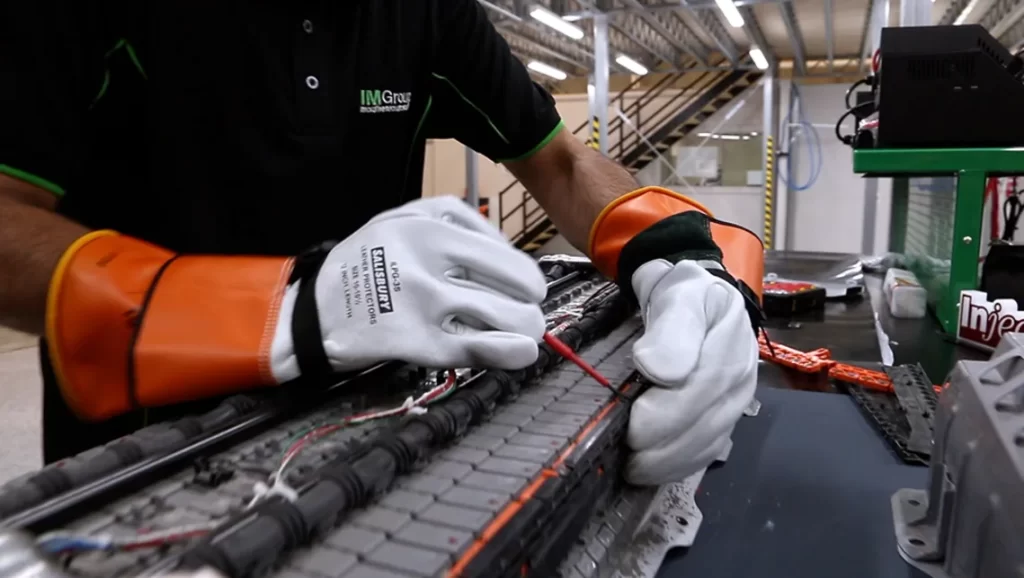
More than 6.6 million electric automobiles are expected to be sold in 2021, according to Statista, In 2020, it was 3 million. Therefore, the problem of recycling electric vehicle batteries will gain importance during the next ten years. Learn about the various ways to recycle electric car batteries if you’re thinking about buying a new electric vehicle.
Take the electric car battery to a recycling facility when it needs to be recycled. The recycling facility will need to know what kind of electric car battery it is because there are various sorts.
There are several ways to recycle electric car batteries, including:
| Ways to recycle electric car batteries | Description |
|---|---|
| Processing | Electric vehicle batteries are processed at electric car battery recycling facilities to remove lead and heavy metals before producing new lead- and heavy metal-free electric car batteries. |
| Disposal | Electric vehicle batteries are processed at electric car battery recycling facilities to remove lead and heavy metals before producing new lead- and heavy metal-free electric car batteries. |
| Collection | To promote the recycling of used batteries for electric vehicles, local governments place collection boxes on street corners. |
How is California Faring with Rechargeable Battery Recycling?
Rechargeable batteries are used by the majority of portable electronic gadgets, and California sells millions of them per year. Battery disposal in the trash is now prohibited in California due to the presence of dangerous elements like nickel, cadmium, lead, and mercury in them. These metals could be dangerous to both people and the environment if they are discharged.
The California Rechargeable Battery Recycling Act, which requires merchants to have a mechanism to take all rechargeable batteries from customers for recycling, was signed by the governor in 2005 to help promote the proper disposal of rechargeable batteries by the general public.
The estimated weight of each type of rechargeable battery returned for recycling in California for the previous calendar year, by weight, is required to be posted on the DTSC website by July 1 of every year in order to monitor the effectiveness of this program.
Rechargeable battery recycling rates in California, roughly, by year
The DTSC estimates the annual collection of rechargeable batteries by type (i.e., nickel-cadmium, nickel metal hydride, lithium-ion, and tiny sealed lead acid) using data voluntarily provided by the major battery recyclers in California.
| Rechargeable batteries | Description |
|---|---|
| Rechargeable Batteries Recycled in 2021: | Batteries made of lithium-ion material weighing 308,578 pounds (Li-ion) Batteries made with nickel-cadmium weigh 175,464 pounds (Ni-Cd) Batteries made of nickel metal hydride weighing 101,056 pounds (Ni-MH) Small sealed lead acid batteries weighing 3,834,716 pounds (SS Lead Acid) Total weight of rechargeable batteries is 4,419,814 pounds. |
| Rechargeable Batteries Recycled in 2020: | Batteries made on lithium ion weigh 408,823 pounds (Li-ion) Batteries made with nickel-cadmium weigh 252,969 pounds (Ni-Cd) batteries made of nickel metal hydride weigh 77,766 pounds (Ni-MH) Small sealed lead acid batteries weighing 4,810,578 pounds (SS Lead Acid) Total weight in pounds of rechargeable batteries: 5,550,136 |
| Rechargeable Batteries Recycled in 2019: | batteries made of lithium-ion weigh 436,135 pounds (Li-ion) Batteries made with nickel-cadmium weigh 390,703 pounds (Ni-Cd) Batteries made of nickel metal hydride weighing 94,156 pounds (Ni-MH) Small sealed lead acid batteries weighing 3,362,910 pounds (SS Lead Acid) Total weight of rechargeable batteries is 4,283,904 pounds. |
| Rechargeable Batteries Recycled in 2018: | batteries made of lithium-ion weigh 289,781 pounds (Li-ion) Batteries made on nickel-cadmium weigh 439,936 pounds (Ni-Cd) Batteries made of nickel metal hydride weighing 110,943 pounds (Ni-MH) A total of 2,545,164 pounds of tiny sealed lead acid batteries (SS Lead Acid) Total weight of rechargeable batteries is 3,385,824 pounds. |
| Rechargeable Batteries Recycled in 2017: | batteries made of lithium-ion weigh 483,150 pounds (Li-ion) Batteries made with nickel-cadmium weigh 360,557 pounds (Ni-Cd) Batteries made of nickel metal hydride weighing 91,793 pounds (Ni-MH) The weight of tiny sealed lead acid batteries is 2,267,334 pounds (SS Lead Acid) Total weight of rechargeable batteries is 3,202,834 pounds. |
Important Reminder.
Rechargeable batteries are described as “compact, non-vehicular, rechargeable nickel-cadmium, nickel metal hydride, lithium-ion, or sealed lead-acid batteries, or a battery pack containing these types of batteries“ under the Rechargeable Battery and Recycling Act. In light of this, the graph has been updated with information that complies with the regulations.
Data Restrictions.
Due to the following factors, it is challenging to estimate how many rechargeable batteries are collected in California for recycling
Some battery recyclers and handlers fail to record the condition of the batteries they are collecting.
Batteries found in recycled electronic equipment (such as laptops and cell phones) are not separately counted but could make up a sizable fraction of the total amount.
In addition, California law does not require battery handlers or recyclers to report the number or weight of batteries collected for recycling, so there may be duplicate data because some battery handlers collect batteries from other collection points (we have made an effort to address this issue by collecting data from major battery handlers who frequently collect batteries from smaller collection centers).
Problems with Recycling.
The chemistry of EV batteries differs from model to model. Although lithium-ion batteries have been in use for commercial purposes since 1991, the technology is still evolving quickly, and it is unclear what EV batteries will look like in 2030.
The variety of shapes that batteries can take presents another difficulty. Unlike regular batteries, EV batteries don’t have a set range of dimensions or shapes. Instead, discrete battery cells are assembled in modules, which are then stacked in a pack and sealed with nearly indestructible glues.
Since there are so many various form factors, it can take hours to disassemble and recycle each one, which drives up the cost of the materials to the point where it is currently less expensive for manufacturers to purchase new materials than recycled ones.
It’s safe to recycle electric car batteries.

Lead-acid batteries are widely used in electric car batteries. Because lead is a heavy metal, recycling it calls for special techniques. Specialized equipment and high temperatures are needed for the recycling process.
Additionally, lead has the potential to escape during recycling, polluting other materials. Although some businesses are striving to create safer techniques for recycling electric car batteries, the technology is still in its infancy. We advise you to always seek professional advice when recycling batteries for electric vehicles.
How Many Recycled Electric Car Batteries Are There?
New electric vehicle batteries are made using recycled electric vehicle batteries. Recycling facilities remove the battery’s lead and heavy metals before reusing the material to create new lead- and heavy metal-free electric vehicle batteries. More than 90% of the battery components for electric cars were recycled at the end of the procedure.
The emission of harmful substances during the recycling of electric car batteries is still a source of considerable concern. Researchers are continuously looking for solutions to recycle electric car batteries without discharging these hazardous substances into the atmosphere.
What Are Batteries for Electric Cars?
The essential part of an electric car is the batteries. They are in charge of charging the electric grid and the drivetrain of the car. They are created from a variety of materials and are specifically intended to last for a long time.
Carbon fiber, lead, nickel-cadmium, and lithium-ion are just a few of the materials used to make electric car batteries. Each variety of battery has special characteristics. The performance and pollutant output of a certain electric car will depend on the kind of battery utilized in that vehicle.
Are Batteries for Electric Vehicles Recyclable?
Battery recycling is possible for electric vehicles. The combustible material, such as plastics and insulation, is first removed during the recycling process using a gas-fired thermal oxidizer. Prior to being discharged into the atmosphere, the plant’s scrubber removes the harmful particles produced by the burning process. A magnetized drum is then used to separate metals from the plastic and insulation. The non-metallic components are finally burnt away to leave a clear battery casing. Following that, the metal is melted and cast into fresh electric vehicle batteries.
The amount of recycled batteries for electric vehicles varies depending on the battery type. The three primary types of batteries used in electric vehicles are lead-acid, nickel-cadmium, and lithium-ion. The majority of recycled batteries for electric vehicles are lead-acid batteries, followed by nickel-cadmium and lithium-ion batteries.
Batteries for electric vehicles can’t always be recycled, though. Nickel-cadmium and lithium-ion batteries can nearly always be recycled, however, lead-acid batteries can only be recycled to a lesser extent. Most nickel-cadmium and lithium-ion batteries that cannot be recycled, along with the final third of lead-acid batteries, end up in landfills. It might be possible to recycle the batteries used in all-electric vehicles whenever technology develops.
The Value of Recycling EV Batteries.
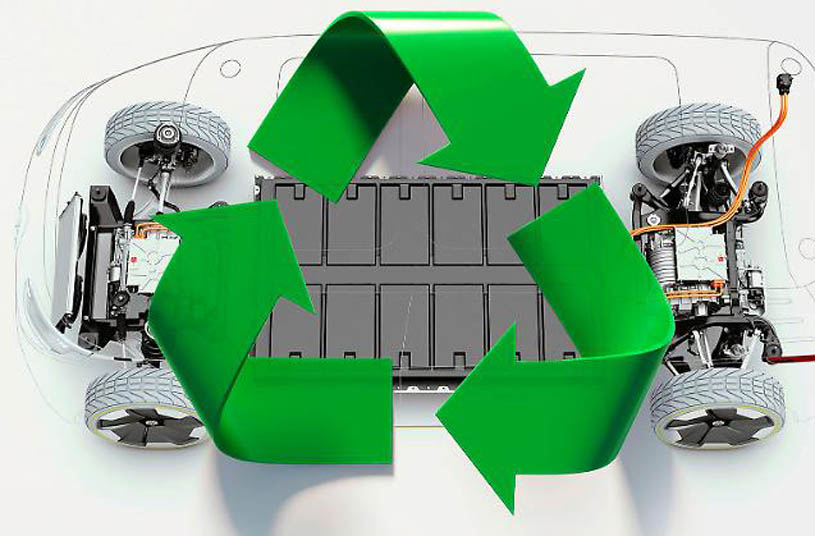
An electric vehicle’s primary component is a lithium-ion battery. They are the most expensive component of EVs and require a supply chain, which could be detrimental to both the environment and human rights.
While electric cars don’t produce any greenhouse gases while they’re in use, the manufacturing process can account for up to 25% of the car’s lifetime emissions.
Lithium-ion batteries need to be kept out of landfills since they are combustible and toxic.
Reduced demand for new lithium, cobalt, and nickel can be greatly helped by recycling and reusing EV batteries. The extraction of these resources has detrimental effects on the surrounding area’s ecosystem and neighborhood residents, such as soil, air, and water pollution.
How Are Old Batteries From Electric Cars Handled?
Most batteries for electric vehicles can be recycled. They are disassembled into metal and plastic pieces before being put back together to create new batteries. This procedure aids in lowering environmental waste and bolsters the economies of nations that recycle battery components.
Old electric vehicle batteries still contain precious minerals and elements that can be used to make new ones, even after they are no longer functional as EV batteries. Additionally, used batteries can be used to make new materials and goods like insulation, paint, and plastics.
How Can Electric Car Batteries Be Removed?
Batteries for electric vehicles can be recycled, however, most recycling facilities lack the tools to manage them. Some individuals recycle them by disassembling them into their component parts, which are then sold. It is feasible to extract the metal and plastic from an electric car battery at the end of its useful life and sell it as scrap. The battery can, however, also be recycled using specialized tools.
Most batteries will eventually be recycled. They would thereafter be considered electronic garbage. Therefore, if you have a battery that is no longer functional, make sure to discard it responsibly.
How Long Does It Take for a Battery to Decompose in an Electric Car?
Compared to conventional batteries, electric car batteries are recycled in a very different way. For instance, it is possible to recycle conventional lead-acid batteries by breaking them up into little pieces and separating the lead from the plastic. Electric car batteries, however, are not made of lead and cannot be recycled in this manner.
How long it takes for an electric car battery to break down is a question that has no clear answer. It could take up to a year, according to some studies, but it could also take up to 10 years, according to other estimates. The primary cause of this variance is the lack of a set criterion for how long a battery must degrade before it is deemed useless.
Can You Recycle Lithium-Ion Batteries?
Lithium, carbon, and sulfur are the main ingredients in lithium-ion batteries. There is a well-established method for recycling these materials. The batteries are crushed into little pieces to start the recycling process. To release the useful materials, this is done. The useful components are then separated and burnt off. New lithium-ion batteries are made from the material that is left behind. Lithium-ion recycling needs to be done by organizations that have the necessary certifications.
Are Tesla Batteries Safe for the Environment?
The batteries from Tesla are constructed from premium recyclable materials. The business runs a recycling program to assist make sure its batteries are disposed of properly. By providing free pickup and drop-off locations across the country, Tesla also makes it simple for consumers to recycle their batteries. More than 60% of the battery components, according to the company, are reused in their goods. Additionally, it is made to be recyclable, reducing its negative environmental effects.
Does Lithium Exist Enough For Car Batteries?
Compared to recycling conventional car batteries, recycling electric car batteries is more difficult. The fact that lithium, plastic, metal, and other materials are used in the construction of electric car batteries is the cause.
By dismantling conventional car batteries, their individual components can be recycled. However, the materials that make up the batteries in electric vehicles must first be separated in order to recycle them.
Because there isn’t enough lithium, recycling electric car batteries can be difficult. Because it provides the battery cells with energy, lithium is an essential component of electric vehicle batteries. It becomes difficult to produce new electric automobiles when there isn’t enough lithium available for recycling. Thankfully, there are enough lithium minerals available to build electric vehicles. As a result, it is always possible to develop new electric vehicles without using lithium. In addition, as technology develops, we might see new ways to power electric cars in the future.
Regulations for Recycling EV Batteries.
Lithium-ion battery production, use, and recycling are already covered by a variety of laws.
Expanding on these will make EV batteries a component of the circular economy.
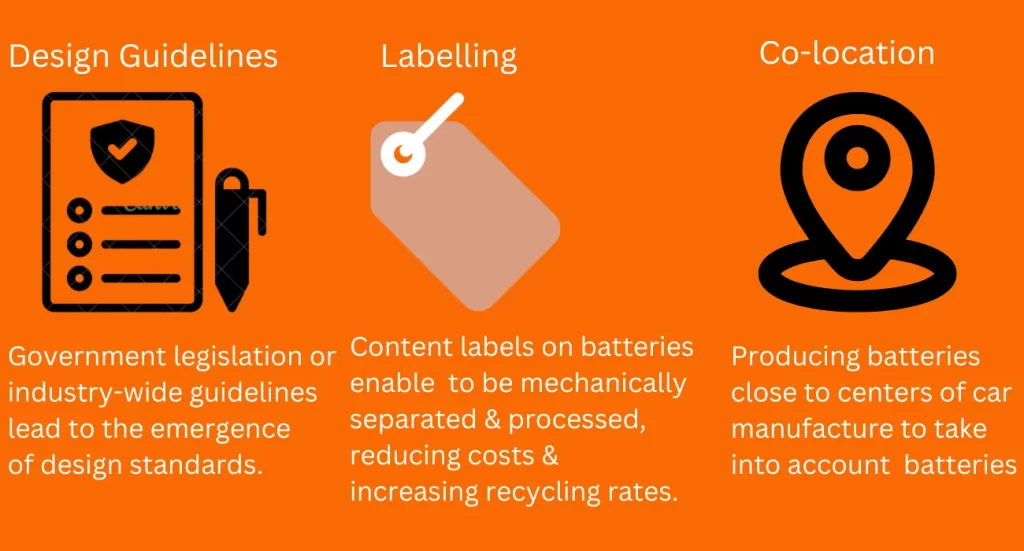
| Regulations for recycling EV batteries | Description |
|---|---|
| Design Guidelines | End-of-life decisions for many products are made by the consumer, not the manufacturer. In a young and disruptive market like electric vehicles, it can be challenging to integrate design requirements into the manufacturing process. However, government legislation or industry-wide guidelines will eventually lead to the emergence of design standards. They have already contributed to recycling initiatives with great success in established areas including lead-acid batteries, glass, automobile catalysts, and aluminum. |
| Labeling | Recycling is most effective when it is labeled. Recycling companies are frequently left in the dark about the anode, cathode, or electrolyte chemistry of EV battery packs. The content labels on batteries will enable them to be mechanically separated and processed, reducing costs and increasing recycling rates, similar to the resin ID code (the number inside the triangle) on plastics. Labeling has also been advised by the Society of Automotive Engineers, a group based in the US that developed standards for battery charging infrastructure. |
| Co-Location | Producing batteries close to centers of car manufacture is another factor to take into account because batteries are bulky and expensive to ship. The cost of EVs can be significantly decreased, and their life-cycle greenhouse gas emissions can be decreased, by combining battery recycling companies with EV manufacturing. |
Benefits of Recycling Electric Car Batteries.

- Recycling electric vehicle batteries can be good for the environment.
- Recycling electric car batteries contribute to a decrease in trash production.
- Recycling the batteries from electric vehicles can also promote local economic growth and lead to the creation of new jobs.
- The battery is the most crucial and integral component of an electric vehicle, making effective recycling of it crucial.
- Recycling electric car batteries result in a reduction in the overall cost of manufacturing electric cars because they contain valuable materials.
- Additionally, it aids in reducing environmentally damaging electrical waste.
Conclusion.
Recycling electric vehicle batteries are good for the environment. Electric car battery recycling can assist local economic growth by adding new jobs while lowering the amount of garbage produced. We have discussed the advantages of recycling electric vehicle batteries in this article. And we responded to the query, “How Are Batteries for Electric Cars Recycled? … some of the other often-asked queries concerning the procedure. Hope this is useful!
Frequently Asked Questions.
May we reuse Ahead of Recycling?
A 12-year-old battery can still hold 76% of the energy it had when it was new because batteries lose 2.3% of their energy capacity per year.
These batteries can be reused after the EV itself has run its course, thanks to the expanding industry of energy storage.
They can be used to power robots or as utility-scale storage to help the electrical grid be more resilient. They can be utilized as energy storage systems in homes. Battery lifespans can be extended by two times through reuse before being recycled.
How Many Batteries From Electric Cars Are Recycled?
Since different organizations have varying recycling rates for batteries used in electric vehicles, there is no conclusive response. Authorities contend that more than 95% of batteries for electric vehicles are recycled. It’s significant to note that this statistic excludes batteries for electric vehicles dumped in landfills. It is envisaged that in the future, batteries from electric vehicles will be recycled more responsibly using techniques like incineration.
Are Enough Rare Earth Metals Available For Electric Vehicles?
Even if there are enough rare earth metals for electric vehicles, recycling them can be difficult. It’s challenging to recycle all of the metals because they are present in everything from wind turbines to iPhones. Environmental issues regarding the extraction, processing and pollution of metals exist as well. Therefore, Greenpeace, a proponent of renewable energy, has called for the creation of alternate sources for rare earth metals.
How Are Batteries for Electric Vehicles Recycled?
A crucial component of an electric car are the batteries. They must assist in getting the car moving. Electric car battery recycling is becoming more significant because the sector is expanding. How Are Electric Car Batteries Recycled? is the topic of this article. Read on to discover more.
How long do electric vehicle batteries last?
Since the EV sector is still relatively new, it is unclear exactly how long these batteries will endure. Ten to twenty years is the typical estimate.
How are spent EV batteries handled?
EV batteries are thought to last longer than the vehicles they are housed in. The battery should be given a second life as home or commercial energy storage after the automobile is no longer operational. It is deconstructed at the very end of its lifespan so that specific materials can be used to create new EV batteries.
Posts related to electric cars and electric car batteries.
- What Do You Think Should Be the Minimum Range for Electric Cars?
- Hyundai Ioniq 12V Battery Replacement Cost
- How To Precondition Tesla Battery for Home Charging?
- How To Select Battery For Electric Car Conversion?
- What Is The Range Of A Mini Electric Car
- What Happens If My Tesla Runs Out Of Charge?
- Tesla Model 3 Range City Vs Highway – Real Testing Done
- When Will Tesla Model 3 Get 4680 Battery-Ultimate Guide 2024
- How Are Tesla Batteries Recycled?
- Why Did My Model 3 Range Decrease?
- How long Tesla Battery Last?
- Electric Car Range At Different Motorway Speeds
- Chevy Bolt Battery Lifespan
- Everything about Electric Car Battery – Complete Guide 2024
